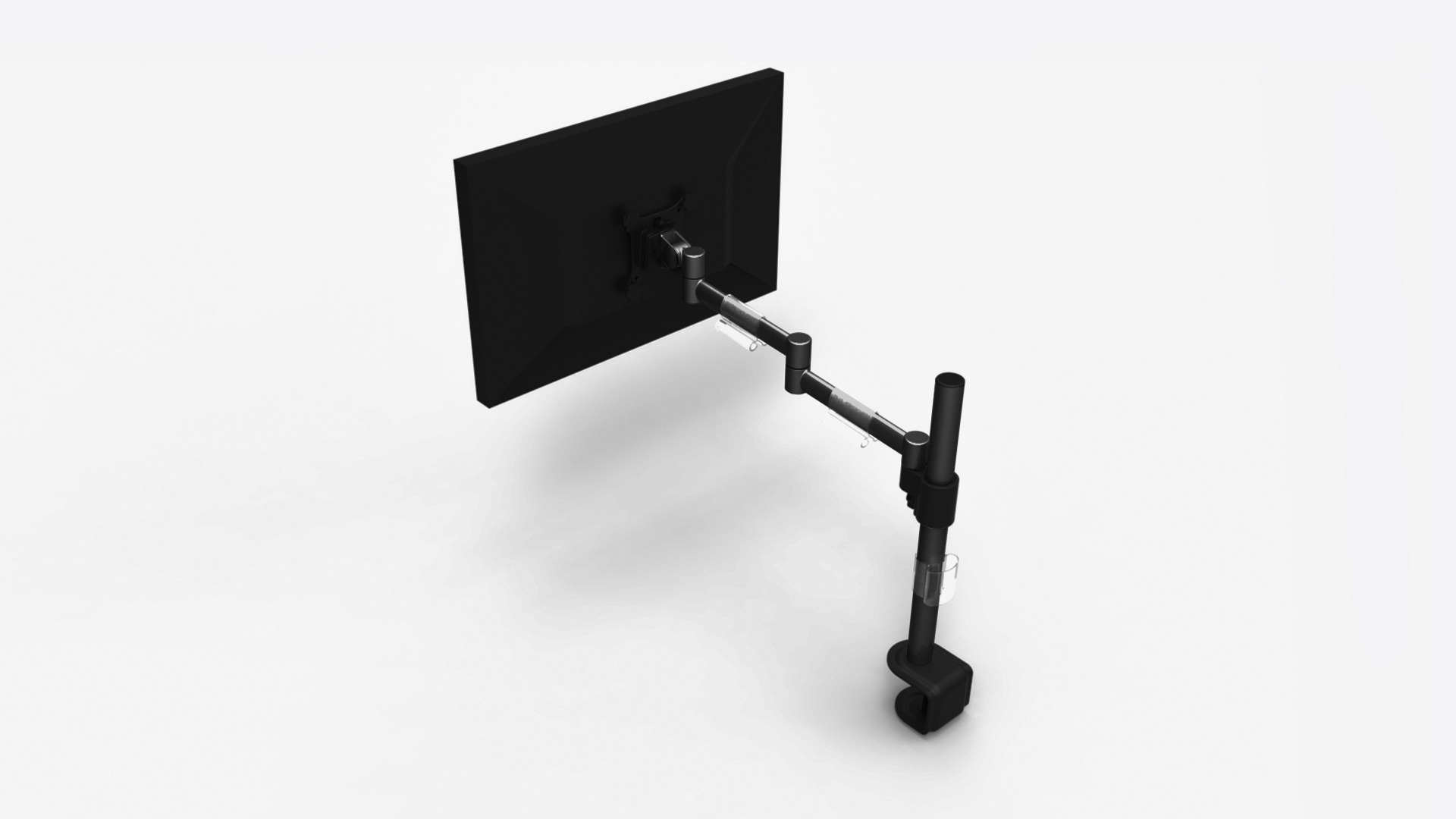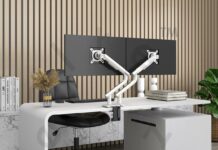Some computers are coming with monitor mounts nowadays, as more and more professionals and individuals mount their computer screens to free up desk space or just simply give their work space a more organized look. The tricky thing is that many monitor mounts that come with a screen or computer are built with cheap materials and fail to ensure your monitor is safe from falling or breaking. A lot of serious professionals will buy a monitor mount separate from any sort of factory packaged monitors, but then the question becomes whether or not you should get a single or double mount for your monitor. Even if you have a single monitor at the moment, there are things to consider when buying your monitor mount.
- Top 8 Best Monitor Arms For Ultra-Wide
- A Complete Guide on the Perfect Adjustable Dual Monitor Stand For Desks
Standingdesktopper's pick
Why Mount your Monitor?
There are numerous benefits to mounting your monitor. The truth is, the very first reason you should consider it is nowadays, most monitors are designed to be mounted. Whether you end up doing it or not, computer monitors manufactured today are designed to be mounted. Flat screen technology that is utilized in today’s modern monitors have specific attachable bolts meant for hanging on the wall to give you optimal viewing options, including different angles and heights that can all be adjusted from one single space.
It is also beneficial for your work space to mount your monitor in order to increase the space you have on your desk. Using a monitor mount is not only efficient, but it saves you a ton of space. Having the extra room on your desk by putting your monitor on the wall or cubicle gives you more area to work when setting up the rest of your work space. Even better some monitor mounts are actually held up by an arm, and require no wall mounting or destruction of the cubicle area at all. These, obviously, are ideal for their minimal footprint on the rest of the office space.
Mounting your monitor also helps your eyes and neck since you can move your mount at an angle or tilt. Most regularly working individuals spend a lot of time at work, often for over 40 hours a week. Most modern professionals need workspaces that can easily adapt to the various changes and problems that may arise during the day. This is especially useful if your mounting at a higher level above office supplies or other things you make keep on your desk.
Your monitor is also significantly safer on a mount than on your desk for various reasons. For starters, it is likely you may bump into a monitor on a cluttered desk. If you knock over a photo frame, that is one thing, but a monitor, some of which cost upwards of $1000+, that is a quick way to put yourself back quite a bit of cash. The safest way to move forward is to grab a monitor mount and keep things from becoming needlessly destroyed. Next, we will take a look at the different setups you can use for your mount.
Types of Monitor Mounts
There are three types of monitor mounts to choose from, and there is one in particular that does the job best. For the purposes of understanding each option, we will go through each one.
Freestanding Mounts
Often considered the most introductory and inexpensive, freestanding mounts are simply a replacement for the standard monitor food or built in stand. Freestanding mounts operate by attaching to your monitor at the top and resting on your desk’s surface, just like a normal monitor built in stand would. This is a better option than the built in stand because replacing your stand with a third-party one can give you more options, including a much greater height that ideally gives you options by placing the center of the screen at your eye level or just below it), panning and tilting, and even rotating the screen itself into a landscape format.
More elaborate models come with spring-loaded rising mechanisms and integrated cable management, but if you are in the market for a freestanding mount, you are usually looking for and want the cheapest option. Single-monitor stands with all the features above can be had for as little as $30.These are awesome options you do not have with a built in mount, but there are drawbacks. For one, you do not clear that space off your desk. They are also ergonomic, but not to the extent that will make a big difference in terms of neck and back pain and optimizing the eye level you need. Other options provide you more space on your desk, and more peace of mind for your expensive monitor.
Through the Desk Mount Stands
For a semi-permanent mount that takes up minimal space on your desk, a through the desk mount offers more security than a freestanding mount. Through the desk stands utilize a single, heavy-duty bolt that goes through a hole in the desk to secure the weight of both the stand and the monitor. The added support comes from that in the desk hole that secures the weight of the stand and monitor, although it does have downsides. Naturally, this limits your options, as you will need to either drill your own hole or have a desk with an existing one, like a standard cable management grommet hole. Of course, there is no guarantee that these will be in the ideal spot for your monitor mount.
For those who want to make sure their stand is a part of the desk, literally a part of the desk that is, a through the desk stand is a viable option. This will not work with all desks; some materials made for various new, modern desks are not as easy to penetrate as wood or plastic. That being said, if this sounds like something you are comfortable doing, you get more security from it than a freestanding mount. If you want the best of both stands, however, the third option is ideal for you.
Side Clamp Desk Mounts
The most favorable option is to use a clamp-style mount, which attaches the riser pole or arm or a mount’s base all the way to the side of the desk. This gives you the advantage of clearing away desk space immediately beneath the monitor, without having to resort to a permanent or semi-permanent installation. Through the desk mount stands are great for their added ability to hold everything safely, but you get the same security with a side clamp desk mount, and without having to drill into your desk. There are a few things you will need for this. You will need a desktop that extends out beyond the legs or support by a few inches—most modern computer desks will do, but older styles with a traditional box shape construction may be incompatible. Installation is easy, and requires only a screwdriver and a few minutes of your time to secure the clamps in place.
Side-clamp mounts can be simple, so if you are not someone who considers themselves very handy this is a good option for you. It is also simple because the mount operates with only a few simple steps, either minimalistically with a few pieces of steel, or elaborately, with multi-jointed arms supported by tightened bolts, There are even gas-spring mechanisms suspending the monitor over the desk and closer to your face. The nice thing about side clamp desk mounts is that you do not have to worry about changing the makeup of your desk, and you also get to enjoy the benefits of a secure and stable stand.
Now that we have talked about the most popular options for monitor mounts, we will look at what specifics make up the best mounts.
What to Look for in a Monitor Mount?
First thing is first, you need to find a monitor that has the ability to do what you want it to. The purpose of a monitor arm is to provide considerably more adjustment to the height, angle, positioning etc. of the monitor, in order to suit the individual. You need to find an arm that does that for you. It is important for your visual health that you can pivot it vertical or landscape to make sure it can adjust when you need to be in a different position. It is crucial that it moves easily when adjusting it as well. If it is a good monitor mount, you will be able to move it back and forth with ease. They also need to be able to extend without feeling like you do not have control over the arm or mount.
You also need to consider whether or not you have multiple monitors. Some companies only offer single screen mounts. Many professionals use two monitors, meaning you may want to consider a double mount. Even if you don’t have two monitors at the moment, down the road, you may want to upgrade your office set up, and it’s frustrating to repurchase office accessories, so a double mount might be a wise choice.
On a daily basis, you are going to run into a lot of things that distract you from your to-do list and workload. That is never going to change. The best thing you can do is set your workspace up to make sure that you do not have anything standing in your way once you have time to stay at your desk and work.
Conclusion
Your computer probably has a mount or leg that it stands on now, and it might not bother you from day to day. Over time, looking down for long periods of time can damage your neck and back, and it is ideal to make sure you are proactive with your office setup rather than waiting for the pain. The monitor you use is where your eyes are most often when you are at your desk. With more and more things going green and digital, you will spend less time looking at papers in the near future and more time staring at a screen. If there are days where you need the screen elongated or a bit further back from your desk, you have options if you have a versatile monitor mount and arm.







